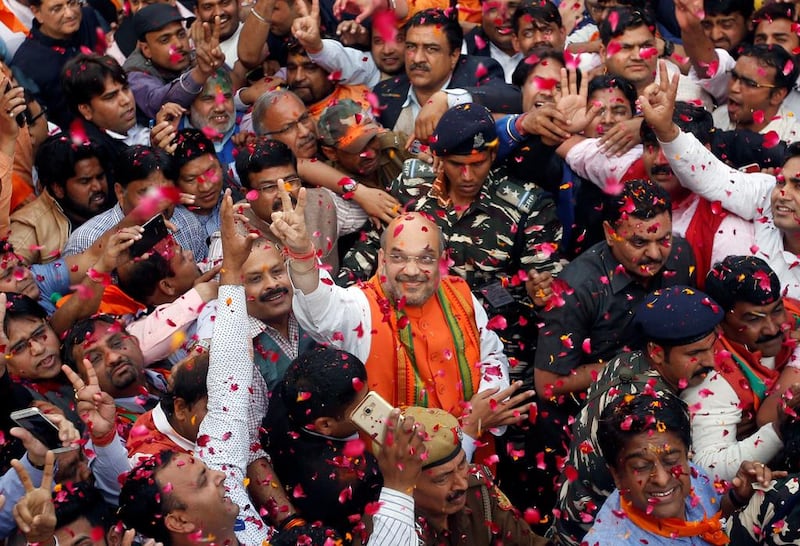Prime minister Narendra Modi led his party to an overwhelming election victory in India’s most populous state on Saturday, cementing his position as the country’s most powerful leader in decades.
The Bharatiya Janata Party (BJP) won 312 of the 403 seats in the Uttar Pradesh legislature — up from 47 seats in the last election, and well ahead of the combined might of the incumbent Samajwadi Party and its ally, the Congress, who won 54 seats in total.
The surge in support is crucial to Mr Modi’s prospects of retaining its outright majority in the next general election in 2019, with Uttar Pradesh accounting for 80 of the 543 seats in the lower house of parliament, and of gaining control of the Congress-dominated upper house, which has blocked legislation needed for key Modi policies.
The BJP also won an overwhelming majority in the neighbouring state of Uttarakhand, ousting the Congress from power with 57 out of 70 seats. The party won 31 seats in the last state election in 2012.
The BJP’s win in Uttar Pradesh bucked expectations that the difficulties caused by Mr Modi’s recent demonetisation policy would cost it the election. On the contrary, by winning Uttar Pradesh in decisive style, the BJP has become the most powerful party in Indian politics, at both state and federal levels, in at least 30 years.
The latest results mean the BJP now rules by itself or in coalition in 15 of India’s 29 states.
The last time a party held this much power was when prime minister Indira Gandhi headed the Congress in the early 1980s. The party’s influence has dwindled since. It was routed in Uttar Pradesh: winning only seven seats compared with 28 in 2012.
The one blip for the BJP was that it fared less well in the other three states that elected new legislatures.
It won only three of the 117 seats in Punjab, where it had been the junior partner in a ruling coalition, while the Congress won 77.
The Congress also won the most seats in the north-eastern state of Manipur – 28 out of 60, compared with the BJP’s 21 – and in the southern state of Goa, with 17 out of 40 seats compared to the BJP’s 13.
However the BJP could still form coalitions to prevent the Congress from retaining power in Manipur and to continue its rule in Goa, where it previously held 21 seats.
The BJP’s triumph in Uttar Pradesh prompted even opposition politicians to acknowledge Mr Modi’s dominance of the Indian electoral landscape.
“At this rate we might as well forget 2019 & start planning / hoping for 2024,” Omar Abdullah, the president of Jammu & Kashmir’s National Conference party, said on Twitter. “Better to face up to reality today & do something about it than bury our collective heads in the sand. A spade is a spade is a spade.”
As the Uttar Pradesh progressed in seven phases over the past month and a half, political analysts speculated that Mr Modi’s forced demonetisation policy – implemented without warning last November – would disenchant voters.
The overnight annulment of 500-rupee and 1,000-rupee notes, which accounted for 86 per cent of currency in circulation, resulted in a cash shortage that hit small traders and businesses; long queues at banks and ATMs; and difficulties in substituting digital payments for cash.
Mr Modi, however, believed that the people would back the move because of its intended goal: to root out the vast sums of undeclared, untaxed wealth held in cash. “He always insisted that the party would not be punished because the goal of demonetisation was a good one, one that people would support,” said a BJP official in Delhi.
Unusually for state elections, the BJP never projected a particular politician as a chief ministerial candidate in Uttar Pradesh. Instead, Mr Modi turned himself into the face of the party and campaigned energetically.
He held more than 24 rallies across the state and forced at least a dozen of his cabinet ministers to hit the campaign trail as well.
Mr Modi emphasised his ability to deliver on policies and his party’s commitment to economic development – both messages that found favour with the 200 million residents of one of India’s poorest states.
But the party also played its Hindu nationalist card boldly, well aware that it could never hope, in any case, to win over the state’s 40 million Muslims.
“Brothers and sisters, if a kabristan [graveyard] is constructed in a village, then a samshanghaat [cremation ground] should also be set up,” Mr Modi said in a speech in February. “If one gets electricity during Ramadan, then one should get electricity in Diwali also.”
Previous state governments, Mr Modi was implying, took particular care of Muslims as a vote bank, whereas the BJP would tend to the needs of Hindus.
On Saturday, as election results began to be announced, the BJP continued to be vocal about its polarising religious agenda.
Speaking to the Times Now television channel, Yogi Adityanath, a BJP parliamentarian from Uttar Pradesh, confirmed that the party had not forgotten its promise to build a temple where a mosque had been demolished by Hindu nationalists in 1992.
The mosque had stood in Ayodhya in Uttar Pradesh, the town where the Hindu deity Ram is said to have been born. The BJP has long insisted that the mosque, built in 1528, stood on the very spot where Ram was born.
“The temple and economic development will go hand in hand in Uttar Pradesh now,” Mr Adityanath said.
ssubramanian@thenational.ae





